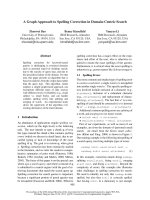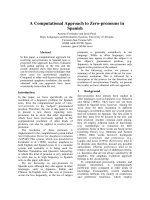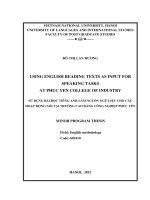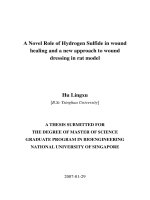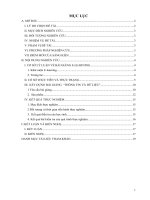Using a model-based approach to teach English writing to 10th graders in Ba Dinh high school, Nga Son, Thanh Hoa = Sử dụng bài viết mẫu để dạy viết tiếng Anh ch
Bạn đang xem bản rút gọn của tài liệu. Xem và tải ngay bản đầy đủ của tài liệu tại đây (972.75 KB, 55 trang )
VIETNAM NATIONAL UNIVERSITY, HANOI
UNIVERSITY OF LANGUAGES AND INTERNATIONAL STUDIES
FACULTY OF POST-GRADUATE STUDIES
*********************
NGUYỄN THỊ LAN ANH
USING A MODEL-BASED APPROACH TO TEACH ENGLISH
WRITING TO 10
TH
GRADERS IN BA ĐÌNH HIGH SCHOOL,
NGA SƠN, THANH HÓA
Sử dụng bài viết mẫu để dạy viết tiếng Anh cho học sinh khối 10 trƣờng
THPT Ba Đình, Nga Sơn, Thanh Hóa
M.A. MINOR PROGRAMME THESIS
Field: English Teaching Methodology
Code: 60140111
Ha noi, 2014
VIETNAM NATIONAL UNIVERSITY, HANOI
UNIVERSITY OF LANGUAGES AND INTERNATIONAL STUDIES
FACULTY OF POST-GRADUATE STUDIES
*********************
NGUYỄN THỊ LAN ANH
USING A MODEL-BASED APPROACH TO TEACH ENGLISH
WRITING TO 10
TH
GRADERS IN BA ĐÌNH HIGH SCHOOL,
NGA SƠN, THANH HÓA
Sử dụng bài viết mẫu để dạy viết tiếng Anh cho học sinh khối 10 trƣờng
THPT Ba Đình, Nga Sơn, Thanh Hóa
M.A. MINOR PROGRAMME THESIS
Field: English Teaching Methodology
Code: 60140111
Supervisor: Ph.D. TÔ THỊ THU HƢƠNG
Ha noi, 2014
i
DECLARATION
I, Nguyễn Thị Lan Anh, hereby certify that the thesis entitled ‗Using a
Model-Based Approach to Teach English Writing to 10
th
Graders in Ba Dinh
High School, Nga Son, Thanh Hoa‘ is the result of my own research in the
fulfilment of the requirement for the Degree of Master of english teaching
methodology – University of Languages and International Studies, Vietnam
National University, Hanoi.
Signature
Nguyễn Thị Lan Anh
ii
ACKNOWLEDGEMENTS
First and foremost, I would particularly extend my deepest gratitude to my
supervisor, Ph.D. Tô Thị Thu Hương for her precious advice, remarkable
suggestions, kind guidance and careful correction.
Next, I would like to acknowledge all my teachers at University of
Languages and International Studies, Vietnam National University, Hanoi,
especially those who are working at the Faculty of Post - Graduate Studies for their
interesting lectures which enable me to gain a great deal of theoretical knowledge
and practical experience.
I am also indebted to all the students and teachers at Ba Đình high school for
their cooperation and participation in this study.
Last but not least, my heart-felt gratitude goes to my family for their
encouragement and support during the process of study.
iii
ABSTRACT
Teaching L2 composition is not an easy task for L2 teachers since it is
affected by the culture and writing conventions of the native speakers. In an
attempt to seek an alternative method to teach L2 writing, this paper reports the
results of the empirical study in which the model-based approach/model-based
teaching was applied to teach English composition to the Vietnamese 10
th
graders.
The study employed questionnaire, direct observation, reflective portfolio and
cross-case analysis technique to discover various aspects of using the teaching
approach in a Vietnamese context. The results suggest that the teaching technique
could be used productively in the Vietnamese EFL environment. Several
suggestions for applying the model-based approach into other similar pedagogical
settings are provided.
iv
LIST OF ABBREVIATIONS
1. MBA/MBT = Model-based approach/Model-based teaching
2. L1= Mother tongue or first language
3. L2= Foreign language or second language
4. CLT = Communicative language teaching
5. EFL = English as a foreign language
6. RQ = Research question
7. ZPD = Zone of Proximal Development
v
LISTS OF FIGURES, TABLES AND CHARTS
Figure 1. Illustration of the concept of ZPD 9
Table 3.1. Writing tasks in English Textbook 10 18
Table 3.2. Classification of writing tasks in English Textbook 10 19
Table 3.3. Comprarison of the mean scores of the question items 20
Table 3.4. Comparison of the test-based scores 27
Table 3.5. Truth table of the Boolean configurations 27
Chart 3.1. Comparison of the mean values of the paragraph-level question items 22
Chart 3.2. Comparison of the mean values of the item ‗I clearly know how to cope
with a writing task‘ 23
Chart 3.3. Test-based scores of the two groups 26
vi
TABLE OF CONTENTS
DECLARATION i
ACKNOWLEDGEMENTS ii
ABSTRACT iii
LIST OF ABBREVIATIONS iv
LISTS OF FIGURES, TABLES AND CHARTS v
PART A - INTRODUCTION 1
1. Rationales 1
2. Aims of the study 2
3. Research questions 2
4. Scope of the study 2
5. Methodologies 2
6. Significance of the study 3
7. Thesis structure 3
PART B - DEVELOPMENT 5
CHAPTER I: LITERATURE REVIEW 5
1.1. Definitions of writing 5
1.2. Approaches to teaching writing 5
1.2.1. The ‗Controll-to-Free‘ Approach 5
1.2.2 The Free-Writing Approach 6
1.2.3. The Paragraph-Pattern Approach 6
1.2.4 The Grammar-Syntax-Organization Approach 6
1.2.5. The Communicative Approach 6
1.2.6. The Process Approach 7
1.2.7 Writing difficulties 7
1.3. A model-based approach in EFL 8
1.3.1. An overview of MBA/MBT 8
2.3.2. MBT/MBT and EFL/ESL 9
2.3.3. MBA/MBT and Vietnamese EFL contexts 11
vii
1.3.2. Implementation of a model-based approach in a writing class 12
CHAPTER II: 13
DESIGN AND ANALYSIS OF THE STUDY 13
2.1. Setting of the study 13
2.1.1. English teaching and learning at Ba Dinh High School 13
2.1.2. English textbook 10 and writing lessons 13
2.2. Design and methodology 14
2.2.1. The participants 14
2.2.2. Data collection instruments 14
2.2.3. Data collection procedure 16
2.2.4. Data analysis procedures 17
CHAPTER III: 18
RESULTS AND DISCUSSION 18
3.1. Writing tasks at the 10
th
grade and MBA/MBT 18
3.2. Students difficulties in writing tasks 19
3.3. Implementation of the model-based approach 23
3.4. Effectiveness of using MBA/MBT to teach writing to the 10
th
graders 26
3.5. Major findings 30
PART C: CONCLUSION 31
1. Conclusion 31
2. Pedagogical suggestions 32
3. Limitation of the study 32
4. Suggestion for further study 33
REFERENCES 34
APPENDICES I
1
PART A -INTRODUCTION
1. Rationales
At present, the requirement of applying Communicative Language Teaching
(CLT) in L2 teaching from Vietnamese Ministry of Training and Education (An
Nguyen, 2011) leads to a focus on development of all the four macro language
skills (listening, speaking, reading, and writing) so that Vietnamese, L2 students are
able to communicate well in the target language. However, teaching-learning
quality at many places is still far from being satisfactory, and Vietnamese learners
have encountered many difficulties in English learning, especially with English
writing skills.
The first is that English at high school, and nearly at all levels of the
Vietnamese educational system, is primarily treated as a compulsory subject, so its
learning and teaching is heavily exam-driven rather than communication-oriented
despite the call for the use of CLT. Multiple choice tests are extensively used to
assess language learners‘ English competence, with a focus on grammar,
vocabulary, reading comprehension and writing–which only requires L2 learners‘
performance on a surface level like sentence-rewriting and jumbled-word activities.
This practice definitely cannot enhance students‘ written communication skills and
leads to teachers‘ teaching of ‗non-communicative‘ writing skills.
Teaching composition in the Vietnamese EFL context today emphasizes the
assistance for students to produce the error-free texts based on the models of correct
language by providing student writers with vocabulary relating to the required topic
and some guiding questions to form their ideas into the finished paragraphs. This
predominantly language-based teaching of writing cannot help the student writer
create compositions to serve the many purposes outside the classroom context. The
endeavour to seek innovative methods to enhance students‘ writing skills and
building up their positive attitudes towards learning this skill is the very drive for us
to engage in this study entitled ‗Using a model-based approach to teach English
writing to 10
th
Graders in Ba Dinh High School, Nga Son, Thanh Hoa’, which
2
implements the model-based approach in an actual classroom to discover its down
and up sides of the teaching technique in a Vietnamese context.
2. Aims of the study
Investigating the situation of teaching and learning English writing to 10
th
Graders in Ba Dinh High School, Nga Son, Thanh Hoa;
Investigating the effectiveness and difficulties in using a model-based
approach to teach English writing to these students;
Providing some suggestions and implications for the improvement of writing
teaching at Ba Dinh High School by using a model-based approach.
3. Research questions (RQ)
(1). What are the types of writing tasks and topics provided for in English 10
textbook that 10
th
graders in Ba Đình High School (BĐHS) have to perform?
(2). What are the difficulties that 10
th
graders in BĐHS most frequently
encounter when performing those writing tasks on those topics?
(3). How is the model-based approach actually applied in my writing class?
(4). How is the application of the model-based approach monitored and
evaluated so that conclusions on its effectiveness, possible problems that
may have arisen in the application and pedagogical implications can be
drawn?
4. Scope of the study
Because of the limitation of a minor study, the author only carries out
research on teachers and 10
th
graders at Ba Đinh High School. The study also
mainly focuses on the effectiveness and difficulties in using a model-based
approach and the activities used in helping students work well in English writing
lessons.
5. Methodologies
Both quantitative and qualitative methods are employed to carry out the study.
With the aim of increasing validity and reliability of the data collected, many
instruments were used. First, survey questionnaires were delivered. The purpose of the
3
survey is to collect data about the current situation of using a model-based approach in
teaching writing at Ba Đình high school. Informal interviews with the colleagues and
the students were also conducted. Besides, reviewing the related documents was also a
method to establish the theoretical background for the study. More specifically, to
address each of the four research questions, the following methods are used:
For RQ1, critical review and analysis of the writing tasks in English 10
textbook were implemented; For RQ2, a survey questionnaire was employed; For RQ3,
classroom observation and reflective portfolio were used; For RQ4, crisp-set
Qualitative Comparative Analysis (csQCA) is used with the assistance of the
TOSMANA software.
6. Significance of the study
Theoretically, the study systemised the theory of a model-based approach to
teaching writing, together with its advantages and disadvantages. The study also
provides suggestions for successful application of the approach into teaching
composition in a real classroom.
Practically, the research provides language teachers and learners with a
number of activities and exercises using the model-based approach in all stages of
writing in English Textbook 10.
7. Thesis structure
Part I – Introduction; This part presents basic information like the rationale,
aims, research questions, scope, significance, methods, and organization of
the study; Part II - Development
a. Chapter 1: Literature Review
The chapter provides an overview of the writing act, writing difficulties
and MBA/MBT, which serves as a theoretical basis for the whole study.
b. Chapter 2: Design and Analysis of the Study
The chapter includes an overview of the approach used in conducting the
study, with a thorough description of the data collection and analysis
procedure.
4
c. Chapter 3: Result and Discussion
The chapter reports the findings of the study and discusses the prominent
aspects to answer the research questions stated in the previous chapter.
Part III - Conclusion
This part presents the conclusions of the whole study, pedagogical
recommendations, limitations of this research, and suggestions for further
studies.
5
PART B - DEVELOPMENT
CHAPTER I:LITERATURE REVIEW
1.1. Definitions of writing
Brannon, Knight and Neverow-Turk (1982: 2) hold that writing is ―a creative
art, not as assembly line operation of locking words together into sentence and
bolting sentences together into paragraphs in accordance with a predefined plan.‖
Writing is also viewed as a communicative process where purposeful
interaction between the participants occurs; it is not a solitary act but the result of
the interaction among people, contexts, and texts (Nunan, 1999) and a process of
via-text communication between the writers (Oluwadiya, 1990). Therefore, writing
is ―a language skill which is difficult to acquire‖ (Tribble, 1996: 3) and ―a process
that occurs over a period of time‖ (Harris, 1993:10).
To sum up, writing is creative, progressive and interactive; it needs practice
and study to develop and requires both physical and mental powers from the
writers.
1.2. Approaches to teaching writing
According to Raimes (1983), there are six approaches to teaching writing,
namely: The Controlled-to-Free Approach, The Free-Writing Approach, The
Paragraph-Pattern Approach, The Grammar-Syntax-Organization Approach, The
Communicative Approach, and The Process Approach.
1.2.1. The ‘Controlled-to-Free’ Approach
In this approach, writing is sequential. At low levels, students are given
sentence-level exercises or controlled compositions to imitate, copy and manipulate.
Students therefore make few mistakes. Only at advanced levels are students allowed
to try some free compositions, in which they can express their own ideas. As a
result, the focus of the teaching of writing is grammar, syntax and mechanics and
accuracy rather than fluency, which likely results in students‘ good grammatical
competence and low communication skills.
6
1.2.2 The Free-Writing Approach
This approach emphasizes both content and fluency. Students work with
given topics and write with little correction from teachers; they are often asked to
write freely on any topic without worrying about grammar and spelling. Frequent
practice helps them write fluently with confidence. Teachers do not correct these
short pieces of free writing but simply read them and may comment on the ideas the
writer expressed, but this lack of concern for accuracy and form has very likely
negative effect on learner‘s grammar competence in writing.
1.2.3. The Paragraph-Pattern Approach
As the name suggests, the paragraph-pattern approach stresses on
organization; student writers copy paragraphs and imitate model passages.
Consequently, exercises to recognise textual patterns, e.g., putting scrambled
sentences into paragraph order, identifying general and specific statements, and
inventing an appropriate topic sentence or inserting/delete sentences, are
extensively used. The principle underpins this approach is that people from different
cultures construct and organize communication with each other in different ways so
students should invest time in learning to organize their ideas well in the target
language.
1.2.4 The Grammar-Syntax-Organization Approach
This approach is, in fact, an extension of the paragraph-pattern one; it
focuses on simultaneous work more than on organization of an essay only. Teachers
adopting this approach draw their students‘ attention to organization while working
on grammar and syntax. In short, it emphasises students‘ recognition of the
relationship between the purpose and the form of the writing in the teaching of L2
writing.
1.2.5. The Communicative Approach
This approach emphasizes the audience and purpose when a piece of text is
composed. L2 students are encouraged to answer two questions: ‗Why am I writing
this?‘ and ‗Who will read it?‘ when they write. Traditionally, teachers are the
7
audience for student writing, but the readership has been extended to other
classmates, who will do the work of responding and commenting, not correcting their
classmate‘s work. Giving students a reason and an audience in advance may well
motivate them to write. This approach should, therefore, be exploited to teach
writing to secondary students as it can vary the situation and context of students‘
writing.
1.2.6. The Process Approach
This approach encourages students‘ communication of ideas, feelings, and
experiences. It is more global and focuses on purpose, theme and text type, i.e., the
reader is emphasized. Writers, thus, not only concern about the purpose and audience of
their writing but also have to make decision on how to begin and organize their writing.
When writing in class, students involve in many stages: setting out ideas, making
plans, writing a first draft, revising the draft after peer feedback, editing their
writing or writing other drafts and finishing the final version.
The viewpoints on the number of stages in the writing process vary. Oshima and
Hogue (1999) suggest five: pre-writing, planning, writing and revising draft and writing
the final copy, but Tribble (1996) recommend four: pre-writing, drafting, revising and
editing. In practice, Vietnamese L2 teachers often divide the writing proccess into three
stages: pre- writing, while- writing, and post-writing.
1.2.7 Writing difficulties
A writer might generally encounter three obstacles, including: psychological
problem, linguistics problems and cognitive ones (Byrne, 1991). In ESL/EFL, L2
learners‘ writing is affected by contexts, cognitive processing, affective factors, and
constraints (Flowerdew, 1999). Also, Kellogg (1994) asserts that anxiety,
motivation, and apprehension towards writing in the L2 have a direct effect on the
development of the writing skills of language learners. Practically, research shows
that L2 learners‘ difficulties in L2 writing include limited vocabulary, problems
with organization and coherence, and deficiencies in the L2 linguistic mechanisms
(Hirose, 2001; Lee, 2002; Fujioka & Shi, 2003) and cohesion (Granger & Tyson,
8
1996).Fan and Hsu (2008) found that students often give irrelevant examples or
inappropriate supporting ideas in their writing and many claim to have ―the ideas‖
but neither the ability nor the skill in the L2 to express them (Khaldieh, 2000).
Besides, L1-L2 variations also impact on students‘ writing negatively.
Research states that L2 learners employ their L1 resources in their L2 composition
(Berman & Slobin 1994) and inform their inability to free themselves from the
influence of the L1 when they write in L2 (Williams, 1984; Zamel, 1983).L2
learners, in fact, use L1 for global organization (Friedlander, 1990) and pay less
attention to revising and editing (Raimes, 1985). Further, L2 learners‘ problems in
organizing their L1 writing affect their L2 textual organization (Hirose, 2003), and
L1-L2 variations in composing processes and features of written texts likely lead
language learners to troubles in their L2 writing (Silva,1993).
Finally, it takes L2 learners a long time to write an L2 text and they are
restricted to a simple writing style (Flowerdew, 1999). Also, it is worth noticing
that L2 learners proficient in speaking and reading may not show a similar pattern
when it comes to writing (Khaldieh, 2000).
1.3. A model-based approach in EFL
1.3.1. Anoverview of MBA/MBT
Modelling is ―the act of determining the defining characteristics of a
model text, that is, a text which is seen as being exemplary of its kind, and
developing methods of duplicating these defining characteristics using different
content‖ (Stolarek, 1994:154), and MBA/MBT is a theoretical approach to teaching
that emerged from cognitive-historical research on mental models (Khan, 2011). It
is any implementation that brings together information resources, learning
activities, and instructional strategies intended to facilitate mental model-building
both in individuals and among groups of learners (Gobert & Buckley, 2000).
MBA/MBT is not alien to educators wordwide; it is, in fact, closely linked
with the social theory of learning, where Vygotsky (1984) laid the foundation for
the concept of release through his ‗zone of proximal development‘ (ZPD): the
9
learner, with external assistance, progresses from his/her present state of
knowledge to a more advanced one where she can function independently,
illustrated as follows:
Figure 1. Illustration of the concept of ZPD
To enable learners to work well in their ZPD, ‗scaffolding‘–temporary
assistance provided by the teacher in helping students carry out tasks or develop an
understanding of the subject so that the students are capable of accomplishing the
tasks by themselves (Hammond & Gibbons, 2001)–is needed. In EFL,
demonstration and modelling are important aspects of scaffolding learning (Burns
& Joyce, 2001), especially in a writing course (Cotterall &Cohen, 2003).
2.3.2. MBT/MBT and EFL/ESL
2.3.2.1. Benefits of using MBA/MBT
MBA/MBT benefits L2 learners in various ways. It meets the requirement of
writing in any culture, which consists of three basic forms of knowledge requisite
for the writer: semantic knowledge, knowledge of models, and knowledge of social
and cultural rules (Purves & Purves, 1986). Models provide exposure to the lexical
items, structural patterns, and conventions of the target language at all levels of
What I can
do
with help
What I
can do
What I can‘t
do
Zone of
Proximal
Development
10
discourse (Watson, 1982). They also allow learners to stress their efforts on one
section of the essay at a time, while introducing them to the important rhetorical
patterns. Some may argue that this approach is overtly prescriptive, but the
predictability of structure enhances learners‘ sense of sercurity (Cotterall &Cohen,
2003). Thus, models can ―still contribute a very great deal to the teaching of
composition, especially in the second or foreign language situation‖ (Watson, 1982:
13).
Others might claim that MBT/MBA neglect students‘ self-sufficiency. This
is not the case. Many daily situations involve predictable and recurring patterns of
language use, without which our interactions would be random and chaotic, and this
requires us to recognize the generic expectations of various situations to produce an
acceptable response (Derewianka, 2003). Thus, MBT/MBA does not neglect
students‘ self-sufficiency but guarantee the use of their self-sufficiency to achieve
their communicative purposes in various contexts.
Finally, the availability of model texts could create a condition for students
to copy and become lazy in the process of learning. Hare (1992) argues that
introducing students to the rules of writing can, in fact, avoid their use of a low
level strategy of copying. Students are likely to copy the model if they do not know
how and what to write. This inadequacy can be easily avoided with a careful lesson
plans and wise strategies used to scaffold students in the process of learning and
teaching.
2.3.2.2. Previous studies of using MBA/MBT in EFL/ESL
Previous studies cover various aspects of using MBA/MBT in teaching L2
composition. Of the seventy instructors who responded to Stolarek‘s study (1991),
76% stated that they use prose modelling on a regular basis in their classes, with
the largest number of respondents believing modelling was most effective in
giving students stylistic models for their writing and in teaching rhetorical modes.
Charney & Carlson (1995) found that models do influence the content and
organization of students‘ texts since reading models seems to have reminded
11
students of genre-specific structural patterns at the sentence level, paragraph level,
or higher discourse levels, thereby increasing the likelihood that the writer used
these patterns while writing. Also, MBA/MBT affects L2 learners‘ writing ability
positively and it significantly improvetheir writing quality compared to those did
not experience MBT (Crowhurst, 1991; Ferris, 1994). Especially, non-native
speakers who had a higher subtopics to sentences ratio than the native speakers
could benefit from learning how to analyze the topical structure of their essays
(Ferris, 1994). Thus, it can be concluded that MBA/MBT has a positive impacts on
L2 learners‘ writing ability and L2 teachers around the world strongly support the
approach.
2.3.3. MBA/MBT and Vietnamese EFL contexts
Presently, that the ―so-called‖ teaching writing approach of composition used
by Vietnamese teachers fails to help students realize and master such features as
purposes, audiences, context and linguistic conventions of text which are the
important features of any text-types (Tuan Luu, 2011), and this claims is strongly
supported by a recent study carried out in a Vietnamese EFL context:
―[…] most students are not able to distinguish between a paragraph
and an essay. Further, as regards the structure of a paragraph
(including a topic sentence, supporting sentences, a closing sentence),
many have not master it yet, so their ideas are arranged randomly and
unclearly and their writings are incomplete [ ] (Thao Lai, 2011: 20).
Non-native speakers normally come into composing situations with a
different set of discoursal and rhetorical expectations as a result of differing in
rhetorical conventions between L2 and L1. This is especially true to Vietnamese
students, whose redundant and indirect style of writing is opposite to English native
writers‘ (Thuy Nguyen, 2008). In EFL, Ferris (1994) claims that these differences
need to be studied within the context of the non-native speakers' first languages,
and need to be taken into consideration in the composition classroom.
12
The above discussion raises the necessity of an alternative approach to
teching composition to Vietnamese learners of English, and MBA/MTB appears to
be a productive approach.
1.3.2. Implementation of a model-based approach in a writing class
1.3.2.1. Preparation
Lesson plans and worksheets are carefully designed with reference to the
literature related to MBA/MBT in EFL/ESL.Models texts are properly illustrative
or accessible to students and contain the linguistic features which define a
particular form of writing. They should be authentic, thematically relevant and
provocative, culturally rich and linguistically challenging, yet appropriate to the
students‘ level of competence (Watson, 1982). In this study, model texts were,
however, composed by the researcher based on the text book and some internet
resources. This is supported by Stolarek (1994) who claims that language teachers
could utilize appropriate student models, or even write models themselves and
Harrison and Treagust (1998) who suggest that analogical models are always
simplified and enhanced in some way to emphasize the attributes required and that
they should be easily understood and remembered by students.
1.3.2.2. Teaching procedures
(1). Introducing a model: students read, analyze and examine a model text;
(2). Focusing on a model: teachers and students discuss the model explicitly
by naming its stages;
(3). Jointly negotiating a model: teachers and students jointly compose a
model under focus;
(4). Researching: students select materials and assess information before
writing;
(5). Independent construction: students write a text individually.
13
CHAPTER II:
THE STUDY
2.1. Setting of the study
2.1.1. English teaching and learning at Ba Dinh High School
Though Ba Dinh High School is the only gifted high school in Nga Son, its
English teaching and learning has several difficulties. Firstly, the class size far
exceeds the standard number for a language class, with approximately 40 students
each. Secondly, the number of technology-aided classrooms is very limited;
therefore, teachers can not apply electronic lessons to the extent that they desire
for. Finally, there is lack of visual aids such as pictures and portable boards from
the school. Thus, the teachers and students are not offered the most convenient
and modern environment to the teaching and learning of English.
As regards students, they are strictly selected to enroll in the school, most are
academically qualified. There are 10 classes in the 10
th
grade with one English
gifted class whose students‘ English proficiency are supposed to be better than
those from the others. In this study, the average level of the majority of the 10
th
graders in the school was selected.
2.1.2. English textbook 10 and writing lessons
CLT underpins the design of English Textbook 10, so the structure of each
unit includes four skills: reading, speaking, listeningand writing. Linguistic
knowledge such as phonetics, vocabulary and grammar areconsidered the means
and condition to form and improve communicative ability. In fact, the learner-
centered approach is also adapted in order to promote students' activeness and
creativeness, in which teachersact as theorganizer and facilitator in the class.
The content of the book is theme-based, with 16 units covering different
topicswhich were contextualized to be suited to Vietnamese students. Further,
learning is task-based, with the activities are designed in the way in which students
are offered opportunities to interact and co-operate.
14
2.2. Design and methodology
2.2.1. The participants
Two classes of 10
th
graders were chosen for the present study. They were
both of mixed ability and supposed to be best represented the average level of
English among the 10
th
graders in the whole school. The total number of students
from these two classes is 70, and they are divided into the ―control group‖ and the
―experimental group‖. All are at the age of 15 or 16 and have 7- year experience of
learning English. The experimental group were taught with MBA/MTB while the
other with regular traditional approach.
2.2.2. Data collection instruments
Data were collected through various techniques: observation instrument, a
reflective porfolio and the particpants‘ writing tests–which were processed using
Crisp-set Comparative Qualitative Analysis (csQCA)with the assistance of a
computer software TOSMANA.
2.2.2.1. Questionnaire
A questionnaire was designed to discover the difficulties which the
participants encountered during their composition in English. The questionaire
consists of 13 items which are selected basing on the literature on the problems
which L2 learners encounter in their L2 writing (see Appendix A). It does not aim
to investigate all kinds of the difficulties that language learners might have but
focus on linguistic aspects of the writing process only, with some questions relating
to timing and the effect of L1 ways of thinking into L2 writing.
2.2.2.2. Observation instrument and reflective porfolio
Since This study employs a n observation instrument and a reflective
porfolio to collect data on the implementation of the model-based approach. The
observation instrument help collect data on the whole process of teaching students
under the model-based approach (see Appendix B for details).
15
Reflective portfolio–a kind of reflective writing (Hughes & Moore, 2007) to
help the researcher to obtain better insights into her teaching by re-examining it.
This provides the basis for improvement in the next teaching segment. Since a
portfolio is a very personal document, it does not conform to any templates but
varies according to individual needs. In this study, the researcher employs Gibbs'
(1988) reflective cycle (see Appendix C) as the guideline for her critical reflection.
2.2.2.4. Crisp-set Comparative Qualitative Analysis and the TOSMANA
software
The csQCA belongs to Configurational Comaprative Methods, which
―allows systematic cross-case comparisions, while at the same time giving justice to
within-case complexity, particularly in samll- and intermediate-N research design‖
(Rihoux & Ragin, 2009, p.20). The method is often used with computer software
named TOSMANA (Tool for Small-N Analysis , which allows to reduce the
complexity of data sets by using Boolean algebra. A
To enable the csCQA work, an assessment grading tools was design to score
the participants‘ writing and a set of characteristics of effective writing—which then
becomes the ‗conditions‘ for the analysis using TOSMANA—were identified.
Assessment grading tool
The assessment grading tool was designed based on the Continua Model of a
Guide to Making Judgments suggested by Grainger (2013). The tool consists of a
continua set of criteria for marking students‘ writing and the equivalent grades for
each set of criteria (see Appendix D). The assessment grading tool allows
examining how better the experiment group perform than the control group, and it is
the basis for later analysis using the TOSMANA software.
Charateristics of effective writing
Several characteristics of effective writing are suggested by researchers and
scholars the available literature relating to L2 writing, including a right format
(Purves&Purves, 1986), coherence (Liangprayoon et al., 2013;Rinnert &
Kobayashi, 2001; Todd et al., 2004), coherence and cohesion (Bloor &Bloor, 2004),
16
appropriate text types (Eggins, 2004; Burns 2001). Finally, Crowhurst (1991)
included the length of a text and mechanical errors for a holistic rating of a text.
As required by the TOSMANA software, the above characteristics are coded
and dichotomised as follows:
[LENGTH] (length): 0 if below 120 words; 1 if above 120 words;
[MERROR] (mechanical errors): 0 if containing serious errors which
might the intelligibility of the text; 1 if only containing minor errors;
[TEXTYPE] (text types): 0 if unsuitable text type; 1 if suitable;
[COHERSI] (coherence and cohesion): 0 if not coherent and
cohesive; 1 if coherent and cohesive.
[FORMAT] (format): 0 if not including a topic sentence, supporting
sentences and a concluding/ transition sentence; 1 if yes.
2.2.3. Data collection procedure
The data on the implementation of MBA/MBT in the classroom were
collected during the process of teaching. Four experienced teachers at Ba Dinh High
School were asked for help; the observation instrument was given to the teachers,
with some explanation and clarification being given. Besides, after each teaching
period, the researcher critically re-examined her teaching experience by reflecting
upon the whole teaching segment, analysing the data.observation instrument, and
searching related literature for further understandings of the problems in the
proccess of teaching.
The data on students‘ performance were collected after completing the two
writing lessons in the form of a writing test; all the participants were required to
compose a 120-word paragraph about their chosen topic from the two topics given
by the teacher. Totally, 70 writen texts were collected.
Finally, the data on students‘ writing difficulties were collected after
students‘ finishing the writing test; 70 questionaireswere delivered to the two
classes and all returned.

